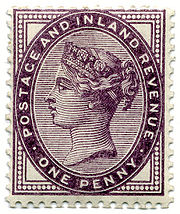
Penny Venetian Red
Encyclopedia

Postage stamp
A postage stamp is a small piece of paper that is purchased and displayed on an item of mail as evidence of payment of postage. Typically, stamps are made from special paper, with a national designation and denomination on the face, and a gum adhesive on the reverse side...
equal to the value of one penny
Penny
A penny is a coin or a type of currency used in several English-speaking countries. It is often the smallest denomination within a currency system.-Etymology:...
. Issued in 1880, it was designed and surface-printed by security printing company De La Rue
De La Rue
De La Rue plc is a British security printing, papermaking and cash handling systems company headquartered in Basingstoke, Hampshire. It also has a factory on the Team Valley Trading Estate, Gateshead, and other facilities at Loughton, Essex and Bathford, Somerset...
. It superseded the Penny Red
Penny Red
The Penny Red was a British postage stamp, issued in 1841. It succeeded the Penny Black and continued as the main type of postage stamp in the United Kingdom of Great Britain and Ireland until 1879, with only minor changes to the design during that time...
that had been used in Great Britain
Great Britain
Great Britain or Britain is an island situated to the northwest of Continental Europe. It is the ninth largest island in the world, and the largest European island, as well as the largest of the British Isles...
since 1841, and was the third one-penny stamp to enter regular usage in the country.
The Venetian Red was aesthetically similar to the Penny Red and Penny Black
Penny Black
The Penny Black was the world's first adhesive postage stamp used in a public postal system. It was issued in Britain on 1 May 1840, for official use from 6 May of that year....
that had come before it, but was instead coloured a venetian red
Venetian red
Venetian red is a light and warm pigment that is a darker shade of scarlet, derived from nearly pure ferric oxide of the hematite type. Modern versions are frequently made with synthetic red iron oxide.-Venetian red:...
and had a square framing. Close to 1.5 million Venetian Reds were printed during the stamp's run; the printing plates used allowed for 240 stamps each. Like its predecessors, the Venetian Red sported individual letters in each of its corners to identify its position on the plate.
| AA | AB | AC | AD | AE | AF | AG | AH | AI | AJ | AK | AL |
| BA | BB | BC | BD | BE | BF | BG | BH | BI | BJ | BK | BL |
| • | • | • | • | • | • | • | • | • | • | • | • |
| • | • | • | • | • | • | • | • | • | • | • | • |
| • | • | • | • | • | • | • | • | • | • | • | • |
| SA | SB | SC | SD | SE | SF | SG | SH | SI | SJ | SK | SL |
| TA | TB | TC | TD | TE | TF | TG | TH | TI | TJ | TK | TL |
The Venetian Red had a short run, and was replaced by the Penny Lilac
Penny Lilac
The Penny Lilac was the basic penny postage stamp of Great Britain from its first issue on 12 July 1881 and was used until 1901. It superseded the short lived Penny Venetian Red because the Customs and Inland Revenue Act of 1881 necessitated new stamps that were also valid as revenue stamps, and so...
in July, 1881. Its displacement is attributed to a change in government postal policy – the Customs and Inland Revenue Act 1881, necessitated the creation of a new provision of revenue stamp
Revenue stamp
A revenue stamp, tax stamp or fiscal stamp is a adhesive label used to collect taxes or fees on documents, tobacco, alcoholic drinks, drugs and medicines, playing cards, hunting licenses, firearm registration, and many other things...
s. A new inscription was therefore needed, and the new Penny Lilacs featured the words "POSTAGE AND INLAND REVENUE" and "ONE PENNY", instead of "POSTAGE" and "ONE PENNY" that its predecessors bore. It was decided that a new colour would also be desirable to defend against improper re-use; a fugitive lilac ink
Fugitive pigments
Fugitive pigments are non-permanent pigments that lighten in a relatively short time when exposed to light. Fugitive pigments are present in types of paint, markers, inks etc., which are used for temporary applications...
was use that would run and spoil the stamp so if one attempted to wash off the cancellation. The Lilacs broke the tradition of using corner letters and instead had either fourteen or sixteen dots in each corner.

